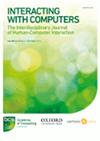Wedge Video: Supporting Remote Participants in a Mixed-Mode Videoconference Meeting
IF 1.3
4区 计算机科学
Q3 COMPUTER SCIENCE, CYBERNETICS
引用次数: 0
Abstract
As global COVID-19 pandemic response has moved from full lockdowns and partial lockdowns in most parts of the world to a post-COVID era, an interesting new phenomenon that has emerged is the increased prevalence of hybrid meetings with a mixture of online and in-person attendees. The opportunity for remote participants to observe the responses and interactions of others in the meeting is generally accepted as being limited. An experimental prototype system, called Wedge Video, has been constructed as an attempt to improve the experience of remote participants in hybrid in-person/remote meetings. Wedge Video uses standard screen and camera equipment with existing video conferencing software (Zoom). An evaluation of the prototype system was conducted based on three simple games that each required players to interact rapidly and with some use of body language or gaze direction. Encouraging results led to the examination of the geometry of screen and camera placement in detail. A system that has a somewhat ‘virtual reality’ feeling to it has now been developed. The remote user is given a view of the in-person part of the meeting with participants at the same scale and location as they would be if the remote user were at the table themselves. Similarly, the local participants see the remote person in place at their table, at a realistic scale and with close to accurate gaze direction. A very preliminary evaluation of these concepts has been promising.楔形视频:支持远程与会者在混合模式视频会议
随着全球COVID-19大流行应对工作从世界大部分地区的全面封锁和部分封锁进入后covid时代,一个有趣的新现象出现了,即在线和面对面与会者混合参加的混合会议越来越普遍。远程参与者观察会议中其他人的反应和互动的机会通常被认为是有限的。一个名为“楔形视频”(Wedge Video)的实验原型系统已经被构建出来,试图改善远程参与者在面对面/远程混合会议中的体验。楔形视频使用标准的屏幕和相机设备与现有的视频会议软件(Zoom)。我们基于三个简单的游戏对原型系统进行了评估,每个游戏都要求玩家快速互动,并使用一些肢体语言或注视方向。令人鼓舞的结果导致检查几何屏幕和摄像机放置的细节。现在已经开发出一种有点“虚拟现实”感觉的系统。远程用户可以看到与参与者在相同规模和位置的面对面会议部分,就像远程用户自己坐在桌前一样。同样地,本地参与者在他们的桌子上看到远程的人,在一个真实的规模和接近准确的目光方向。对这些概念的非常初步的评估是有希望的。
本文章由计算机程序翻译,如有差异,请以英文原文为准。
求助全文
约1分钟内获得全文
求助全文
来源期刊

Interacting with Computers
工程技术-计算机:控制论
CiteScore
2.70
自引率
0.00%
发文量
12
审稿时长
>12 weeks
期刊介绍:
Interacting with Computers: The Interdisciplinary Journal of Human-Computer Interaction, is an official publication of BCS, The Chartered Institute for IT and the Interaction Specialist Group .
Interacting with Computers (IwC) was launched in 1987 by interaction to provide access to the results of research in the field of Human-Computer Interaction (HCI) - an increasingly crucial discipline within the Computer, Information, and Design Sciences. Now one of the most highly rated journals in the field, IwC has a strong and growing Impact Factor, and a high ranking and excellent indices (h-index, SNIP, SJR).
 求助内容:
求助内容: 应助结果提醒方式:
应助结果提醒方式:


